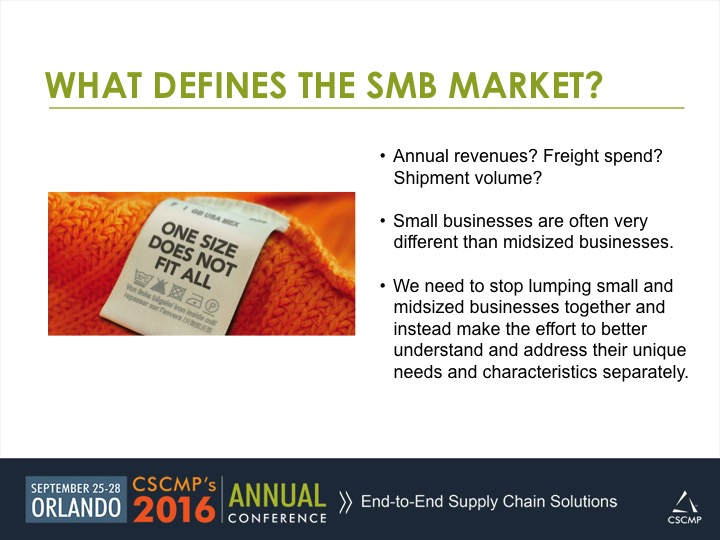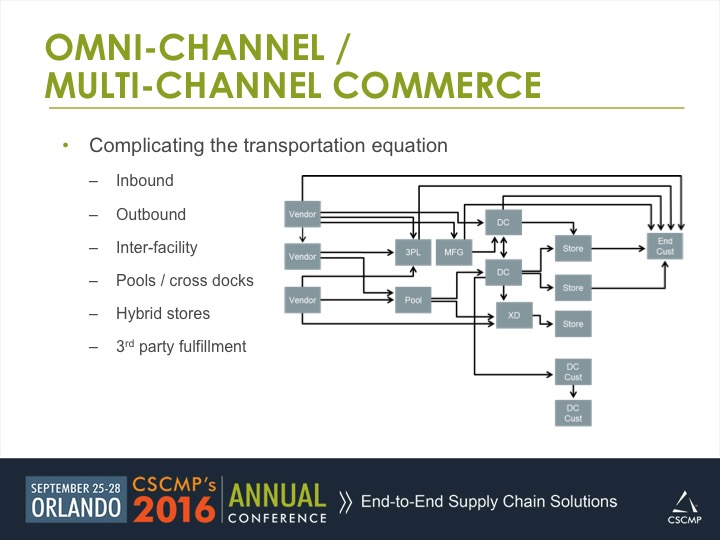What defines the small and mid-sized business (SMB) market for transportation management systems (TMS)?
I began my presentation at last month’s Council of Supply Chain Management Professionals (CSCMP) Annual Conference with that question, in a session titled “TMS for SMB: A Case Study with Carhartt,” where I co-presented with Andra Gibson (Project Manager, Logistics Service Solutions at Carhartt) and Gregg Lanyard (Director, Product Management at Manhattan Associates).
Is SMB defined by a company’s annual revenues? Its freight spend? Its annual shipment volume?
The answer, as I’ve argued before, is that we can’t view the SMB market as a “one-size-fits-all” category, especially when it comes to TMS requirements. For starters, small businesses are often very different than midsized businesses, so we need to stop lumping them together. At the end of the day, the best approach is making the effort to truly understand and address the unique needs and characteristics of every company — both today and where they’re aiming to be in the future.
Carhartt is a great example. This family-owned company — a leading brand in durable workwear and outdoor apparel — was founded in 1889 but its business continues to change rapidly. As Ms. Gibson highlighted in her presentation, Carharrt is experiencing rapid growth. Its manufacturing capacity is at the highest level in the company’s history, and just two years ago Carhartt began opening its own retails stores across the country (with stores in 17 states as of the end of September 2016).
Rapid growth, coupled with new market segments and channels (including ecommerce), prompted Carhartt to embark on a multi-million dollar upgrade of its distribution center, which included investments in warehouse management and transportation management solutions.
From a transportation standpoint, Carhartt came to the same realization that many other fast-growing companies ultimately come to: if they wanted to drive efficiency, control headcount, gain greater visibility, and reduce overall freight costs, they could no longer rely on Excel spreadsheets to manage their transportation operations, especially with the diverse set of modes and channels they were now dealing with.
Carhartt evaluated several TMS solutions across a broad set of functional requirements, including:
- Order Management
- Location Management
- Capacity Management
- Procurement & Contract Management
- Rate Management
- Carrier Communication
- Planning & Optimization
- Shipment Management
- Visibility & Event Management
- Freight Bill Audit & Pay
- Reporting & Analysis
- Modeling
The company ultimately selected Manhattan Associates’ cloud-based TMS (Carhartt was already using Manhattan’s WMS solution and was planning to upgrade it at the same time). Why Manhattan? Obviously, the solution met Carhartt’s functional requirements, but there was another important factor that Gibson highlighted, a factor that many other companies sometimes fail to consider: “It was important for us that the vendor and solution we selected was capable of growing with us as our processes developed and matured,” said Gibson.
In other words, Carhartt incorporated its long-term strategy and objectives into the selection process — that is, the company didn’t only factor in the TMS capabilities it needed today, but also the capabilities it anticipates needing in the future as its business and transportation operations continues to grow and evolve.
Cloud-based deployment was another contributing factor in Carhartt’s selection. “Our company’s philosophy regarding on-premise installations has evolved based on the need for quick deployment of on-demand, integrated solutions,” said Gibson. “Being current [with the latest TMS version via regular updates] is important with the evolving needs of our supply chain network.”
Carhartt went live with the TMS in February 2016 and the company is already experiencing benefits, including improved carrier and mode selection, enhanced service levels, improved visibility into customer delivery, and decreased overall transportation spending. In a press release issued by Manhattan Associates prior to the conference, Sharon Perry, vice president of logistics at Carhartt stated the following:
“Our adoption of Manhattan’s cloud-based TMS and the ease of implementation has given us greater visibility into the supply chain, directly impacting our ability to be agile and adapt to the different levels of sophistication that our customers and carriers demand. We can now offer customers flexibility to experiment with different delivery methods, which is especially important during peak season.”
Gregg Lanyard from Manhattan Associates also presented during the session. He will be my guest on Talking Logistics in an upcoming episode, so I don’t want to steal his thunder today. I’ll simply share the slide below from his presentation:
I believe this slide sums up the transportation challenge that Carhartt and many other companies — whether they’re small, medium, or large — are experiencing today when it comes to omni-channel/multi-channel commerce, and why companies can no longer get away with managing their transportation operations with spreadsheets or outdated systems.











